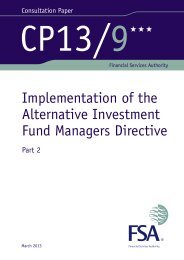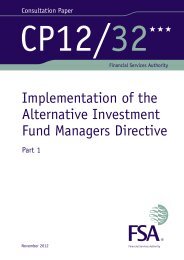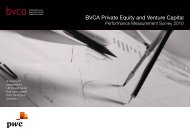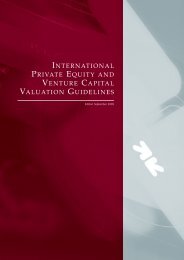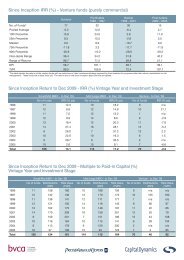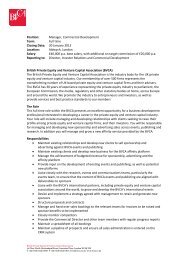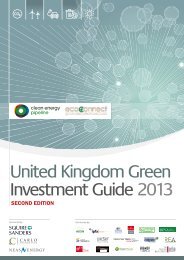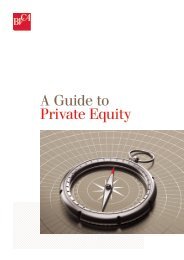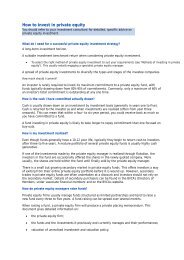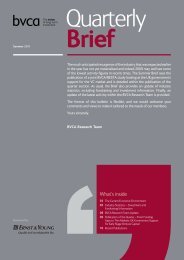BVCA Private Equity and Venture Capital ... - BVCA admin
BVCA Private Equity and Venture Capital ... - BVCA admin
BVCA Private Equity and Venture Capital ... - BVCA admin
You also want an ePaper? Increase the reach of your titles
YUMPU automatically turns print PDFs into web optimized ePapers that Google loves.
36 <strong>BVCA</strong> <strong>Private</strong> <strong>Equity</strong> <strong>and</strong> <strong>Venture</strong> <strong>Capital</strong> Performance Measurement Survey 2011<br />
Appendix II – Glossary of terms<br />
Continued<br />
Principal comparators<br />
The principal comparators are the FTSE UK<br />
<strong>Equity</strong> <strong>and</strong> FTSE World <strong>and</strong> Europe (ex-UK)<br />
Indices <strong>and</strong> the UK <strong>Equity</strong>, Overseas <strong>Equity</strong><br />
<strong>and</strong> total assets returns of the WM All Funds<br />
Universe. The figures are detailed in Appendix<br />
III of this report.<br />
Range of returns: quartiles/deciles/percentiles<br />
The ‘Range of returns’ represents the results<br />
of a universe of portfolios constructed for the<br />
purposes of comparing performance. Within<br />
each range, a portfolio’s results are defined in<br />
terms of a percentile ranking. Ranges can be<br />
subdivided by quartiles, deciles <strong>and</strong> percentiles.<br />
The range between the tenth <strong>and</strong> ninetieth<br />
percentile is known as the ‘interdecile’ range.<br />
Top decile<br />
Tenth percentile – 10% of the funds have an<br />
equal or higher return than this value.<br />
Upper quartile<br />
Twenty-fifth percentile – 25% of the funds have<br />
an equal or higher return than this value.<br />
Median<br />
Fiftieth percentile – The return of funds in the<br />
middle of the ranking.<br />
Lower quartile<br />
Seventy-fifth percentile – 75% of the funds have<br />
an equal or higher return than this value.<br />
Bottom decile<br />
Ninetieth percentile – 90% of the funds have an<br />
equal or higher return than this value.<br />
Pooled average<br />
IRR or return for the total sample of funds<br />
being analysed.<br />
Return<br />
The annualised internal rate of return (IRR)<br />
achieved over a period of time, based upon the<br />
portfolio cash flows <strong>and</strong> valuations. The cash<br />
flows used in the calculations are the total<br />
actual fund cash flows <strong>and</strong> the returns are<br />
therefore time-weighted <strong>and</strong> money-weighted.<br />
This type of calculation is often referred to<br />
as ‘time line basis’ (see also Methodology<br />
‘Calculation of Return’).<br />
Total return<br />
Aggregate of all cash flows.<br />
Universe<br />
A group of similar portfolios assembled to<br />
provide a benchmark against which the<br />
performance of an individual portfolio may be<br />
compared. Any such universe should comprise<br />
portfolios with similar investments <strong>and</strong> objectives,<br />
<strong>and</strong> the same domicile <strong>and</strong> tax status.<br />
Valuations<br />
This refers to the assessed value of the unrealised<br />
part of the portfolio, which is assumed to be<br />
realised at 31 December 2011 in the final return<br />
calculation. This assessment is carried out in<br />
accordance with the International <strong>Private</strong> <strong>Equity</strong><br />
<strong>and</strong> <strong>Venture</strong> <strong>Capital</strong> Valuation Guidelines.<br />
Vintage year<br />
Year of first closing of the fund, that is, the year<br />
in which a fund has raised an initial sum of<br />
money with which to commence its investment<br />
programme.<br />
WM All Funds Universe<br />
The WM All Funds Universe is the largest<br />
available universe of UK pension funds.<br />
It represents some two-thirds of the UK<br />
defined benefit pension industry by value.<br />
Weighted average (Principal comparators)<br />
The aggregate returns of a number of like<br />
portfolios, the results of which are used for<br />
comparing performance. The weighted average<br />
for a number of portfolios is calculated by<br />
weighting each individual portfolio’s return<br />
by the proportion (by the average value of<br />
investment over the period) of the combined<br />
total that it represents.



